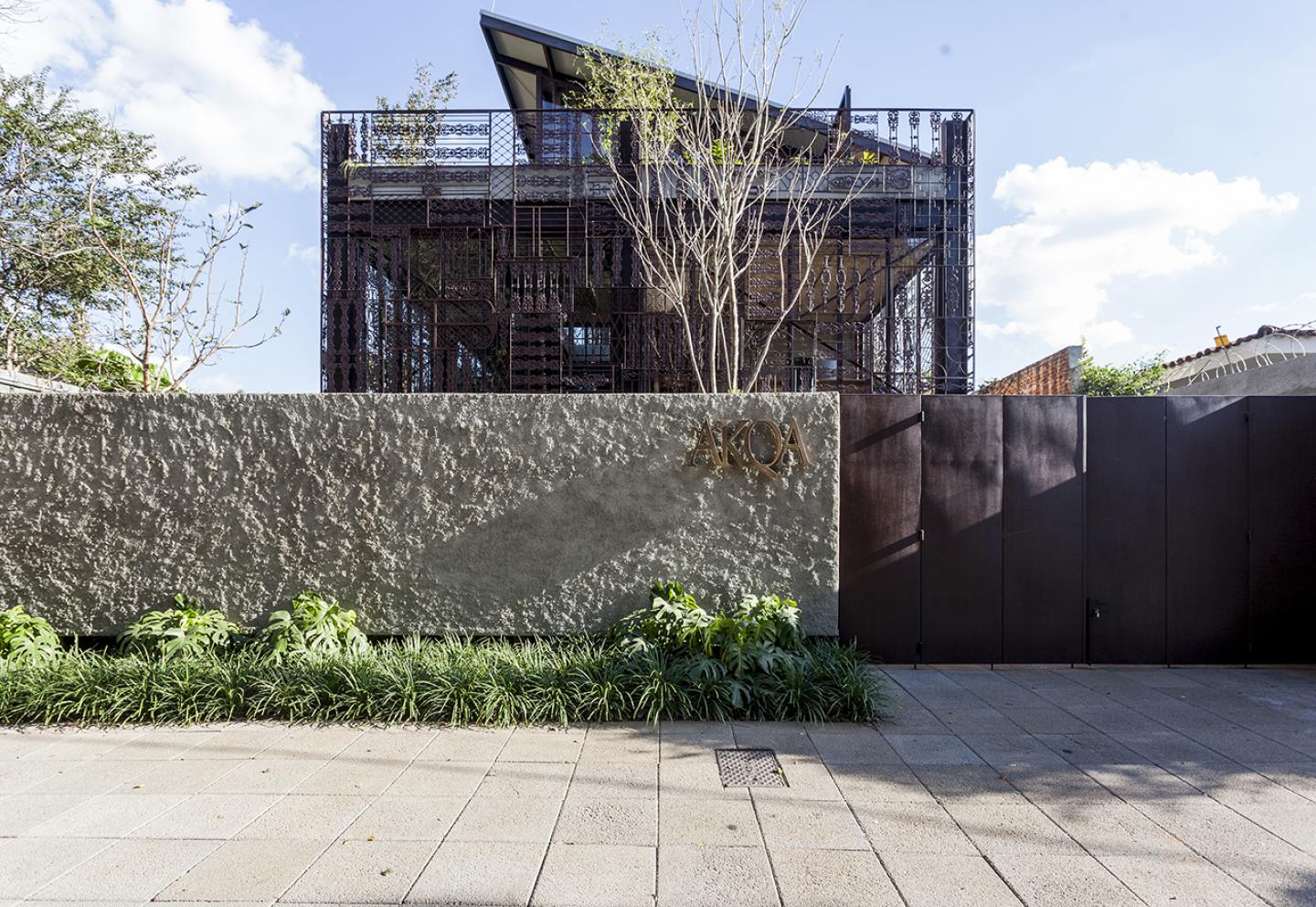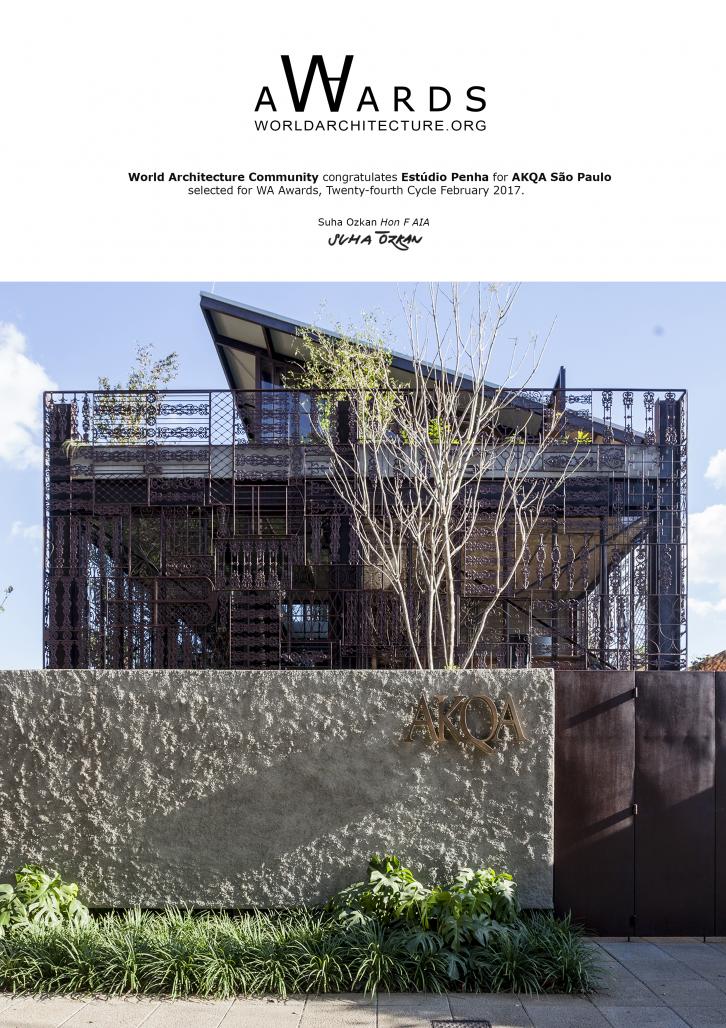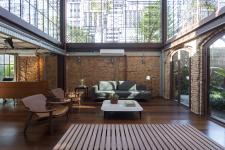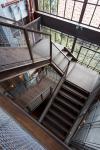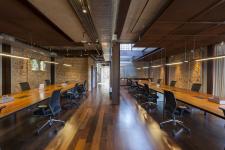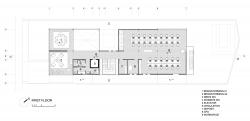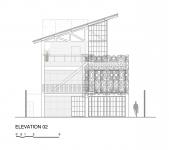AKQA, an international advertising agency that planned to come to Brazil ordered a project to create an office with a homelike atmosphere and with the coziness and soul of our projects.
The architecture of the 70s two-story house was created by the former owner with arches and structural walls made of solid brick that we wanted to preserve. The starting points were: to maintain the constructive memory that had to be valued, to integrate the new environments with the existing ones, to create a garden that would permeate throughout the entire house and to think about sustainable consumption solutions.
A project was developed to make good use of the majority of the rooms on both floors. On the ground floor are the main areas for clients and for their support, in the external area all of the setback areas were used as permeable areas creating a large garden around the house and in the backyard, where the former pool existed, rows of seats were projected for exhibition of films and presentations. The main access consisting of an oxidized iron box that leads to the reception and the space for expositions has triple height that reaches the leaning roof and invites the visitor to make a curious glance upwards. The façade wall does not reach the floor, the vegetation grows underneath creating the necessary delicateness that balances with its height. The corridor for reaching the meeting rooms also distributes the apparent pipelines of the entire infrastructure of the house and, at its end is the main meeting room – a new environment of the house, with window frames that enable a view of the garden all the way from the reception. The new vertical circulation located where the former stairway of the house existed became highlighted due to having hollow elements as steps and metallic structure handrails. It is set between window frames, a big one providing a view of the side garden and another with a view to the internal patio. Still bearing in mind the integration between the interior and exterior, folding doors were used to enable a wider opening and, as a consequence, a visual and physical connection between the rooms and the garden.
On the first floor, with a view to the back of the house, is the area for 40 members of the staff. A portion of this room has double height connecting with the canteen, which is on the last floor and it is lit by large window frames. In front, the new cantilevered block that holds the brainstorming rooms serves as a covering for the entrance and garage of the house.
For the new floor, two mezzanines: one includes the leisure area that connects with the reception and the other includes the canteen that connects with the staff area, all of which are integrated by a large green roof with medium-sized plants. The accesses to this outdoor garden are two large wooden gates that replace the walls and open so as to integrate the external and internal environments and also create additional protection against East and West sunshine. On rainy or cold days a small door in this panel enables circulation.
A covering in thermo-acoustic tile inclined to the North side was built, which helps in the control of sunshine. On the South façade, a large window frame enables the entry of natural lighting throughout the entire combination of environments through the mezzanines. An outside New York-type fire escape stairs fulfills the safety demands.
The element that provides identity to this project is the patchwork of old iron gates and railings that operate as brise soleil for the new environments of the house, as they draw the flooring as a lace formed by the morning sunshine.
One of the objectives of the project is to make clear and harmonic the contrast between the old house and the new interventions, whereby the plaster was removed from the walls to make the bricks apparent. For the new internal walls we used structural concrete blocks with linear pagination, contrasting with the tied-up pagination of the existing bricks. On the outside, the high and low walls, including the closure of existing windows, were made of cast-in-place concrete. The window openings of the old construction were preserved and closed with new glass panes so as to preserve the superposition between the old and the new.
It was necessary to project a complex net of ducts and pipes for connection of electricity, hydraulics, lighting, network, sound, sprinklers, air conditioning, and this was accomplished in an apparent way, showing clearly the complex infrastructure that causes the house to “function”, an aesthetic decision that is not restricted to this, it helps easy maintenance.
The large industrial-type iron frameworks enable the entry of natural lighting during the day and constant integration with the outside gardens and a view of the city from the roof.
As the idea of integration permeates the entire project, it was necessary also to think about protection of privacy and peacefulness for work, whereby acoustic clouds were adopted in the production rooms and in the main meeting room, in addition to acoustic doors.
For the implementation of this project, the old house required a structural reinforcement. We chose a metallic structure where the pillars become, in addition to an important structural element, an aesthetical element that makes the vertical connection of all floors, with new and reminiscent elements.
New technologies and the consciousness with the preservation of the planet´s natural resources permeate the project. Reused or certified wood was used and also elements that were already part of the house, such as brick walls and tiles. In this same sense, the use of sustainable systems like solar panels gathering of rainwater for reuse and lighting with led lamps, causes the use of the house to occur in a way that minimizes the use of electric power and treated water.
2014
2016
Address: Rua dos Macunis, 455
District: Pinheiros
City: São Paulo / State of São Paulo
Cep (zip code): 05444-001
Land area: 647m²
Built area: 570m²
Architecture project: Estudio Penha
Interior design project: Estudio Penha
Lighting project: Estudio Penha
Supplementary projects:
Air conditioning: Prorac
Acoustics consultant: Harmonia
Power system: Green Projetos e Consultoria
Hydraulics: Green Projetos e Consultoria
Structure: Enplatec Projetos de Engenharia
Landscaping: Rodrigo Oliveira
Work execution: Grupo Lock Engenharia
Vitor Penha
Verônica Molina
Simone Balagué
Ricardo Souza
AKQA São Paulo by Estúdio Penha in Brazil won the WA Award Cycle 24. Please find below the WA Award poster for this project.
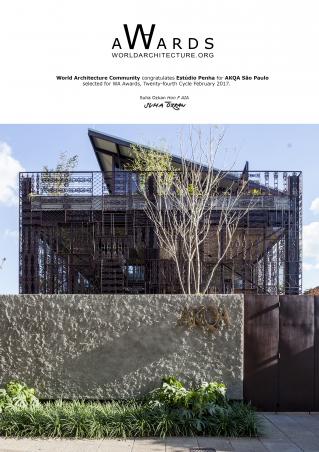
Downloaded 667 times.
